Microsoft Excel is one of the popular spreadsheet programs. It mainly used for calculation, analyzing data, and creating graphs or charts [1]. While we can present our analysis and chart using Excel, it may not be the best way to present to the client. Therefore, sometimes we only need to export the chart and show it to the client in another program.
Unfortunately, there is no save as picture option for a chart in Microsoft Excel. In this case, we provide you with some alternative ways to export the chart.
1. Reuse on another MSO program
While we can export the chart into a picture file, sometimes we just need to use it in another Microsoft Office (MSO) program. This method will keep all the data and formatting. So you could edit them on another MSO program without opening Microsoft Excel.
1.1. Microsoft Word
We may need to reuse the chart on our report using Microsoft Word. To do that, basically, we only need to copy the chart and paste it directly on Microsoft Word as in Figure 1. The detailed steps are as follows:
- on Microsoft Excel, click the chart you want to copy,
- press
CTRL+Con your keyboard to copy the chart, or you could right-click the chart frame and selectCopy, - on Microsoft Word, click the location you want to paste,
- press
CTRL+Von your keyboard to paste the chart.
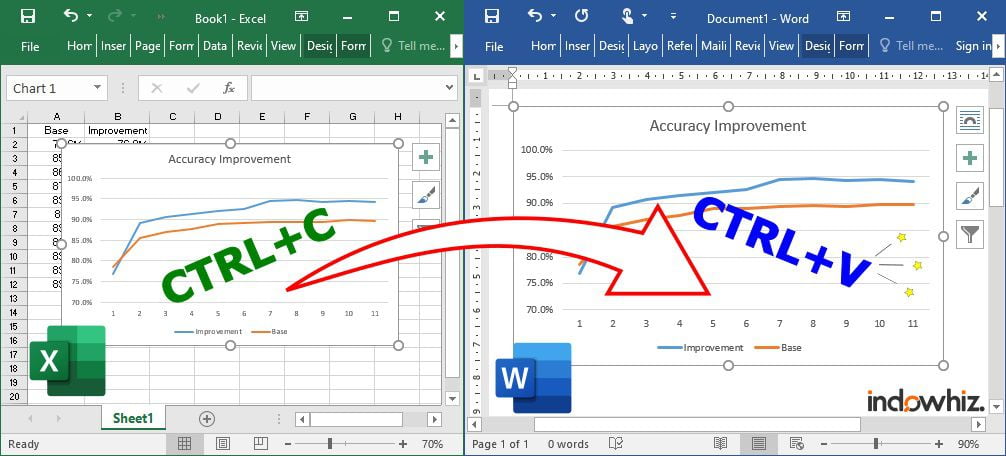
1.2. Microsoft PowerPoint
In another circumstance, we may need to reuse the chart on our presentation using Microsoft PowerPoint. To do that, basically, we only need to copy the chart and paste it directly on Microsoft PowerPoint as in Figure 2. The detailed steps are as follows:
- on Microsoft Excel, click the chart you want to copy,
- press
CTRL+Con your keyboard to copy the chart, or you could right-click the chart frame and selectCopy, - on Microsoft PowerPoint, click the slide you want to paste,
- press
CTRL+Von your keyboard to paste the chart.
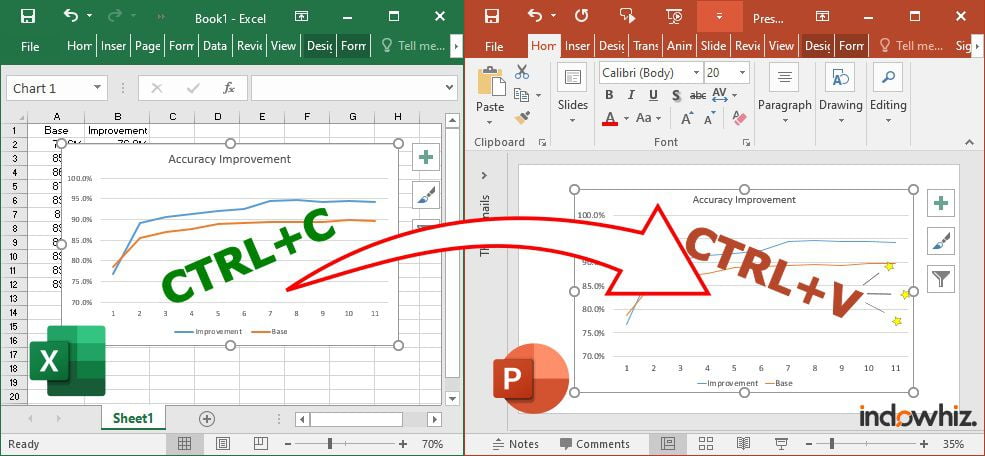
2. Export as bitmap file
In some cases, we may need to export our chart to a bitmap file. There are several ways to accomplish that, which is by using any graphics software or using Microsoft PowerPoint.
However, the resolution of the image file will be as large as the original chart size with 96 DPI. Therefore, if you need a larger picture, you need to enlarge the chart in Microsoft Excel before saving it as bitmap. Alternatively, you could save the chart as vector as in section 3.
2.1. using graphics software
The easiest way is to use any graphics software to save it as a bitmap. The graphics software we can use includes Microsoft Paint, Gimp, or Adobe Photoshop. However, if you are using Windows, the easiest way is to use Microsoft Paint. The steps are as follows [2]:
- on Microsoft Excel, click the chart you want to save as bitmap,
- press
CTRL+Con your keyboard to copy the chart, or you could right-click the chart frame and selectCopy, - open graphic software (e.g. Microsoft Paint),
- press
CTRL+Von your keyboard to paste the chart, - then in graphic software (e.g. Microsoft Paint), go to
File>Save as, - then select one of the file types you need (e.g. PNG, JPG, or BMP), as in Figure 3.
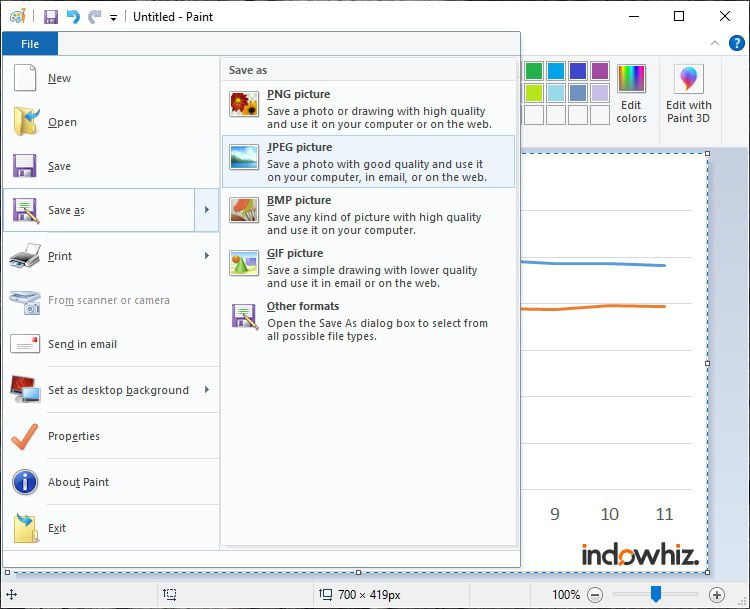
Save as options in Microsoft Paint2.2. using Microsoft PowerPoint
While we can use any graphics software, we can also use Microsoft PowerPoint to save a chart as a bitmap file. The steps are as follows:
- on Microsoft Excel, click the chart you want to copy,
- press
CTRL+Con your keyboard to copy the chart, or you could right-click the chart frame and selectCopy, - on Microsoft PowerPoint, click on a slide you want to paste,
- press
CTRL+Von your keyboard to paste the chart, - right-click the chart frame in Microsoft PowerPoint, then select
Save as Picture…, as in Figure 4, - then select one of the file types you need (e.g. PNG, JPG, BMP)
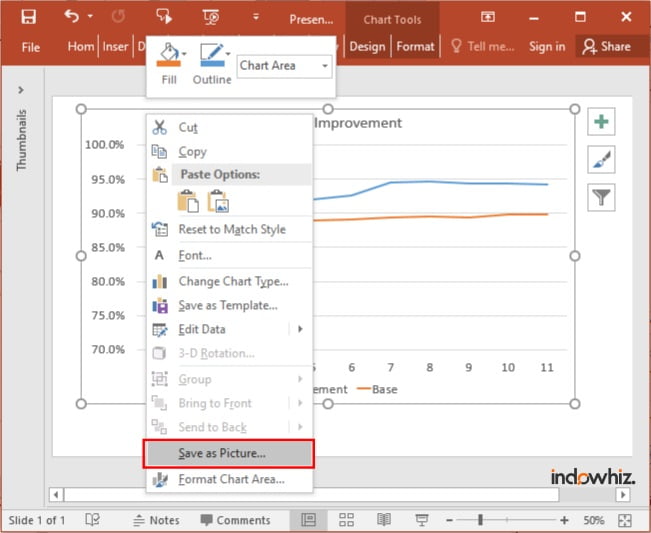
Basically, you only need to copy and paste the chart into Microsoft PowerPoint as in section 1.2 above, then right-click the chart and click Save as Picture.
3. Export as vector
A vector file type may help you when you need an high-resolution image file. There are several ways to accomplish that, which is by directly saving the chart as PDF file or by using Microsoft PowerPoint to get EMF file. Then you can read that file in any vector graphics software such as Inkscape, CorelDRAW, or Adobe Illustrator.
3.1. Export as PDF
In Microsoft Excel, we may need to do complicated steps to save a chart as standard image file. However, we can export the chart as vector in PDF format with ease. The steps are as follows:
- on Microsoft Excel, click the chart you want to export as PDF,
- go to
File>Save As, then select the desired location to save the file, - select
PDFin theSave as type:, as in Figure 5, - click
Save.
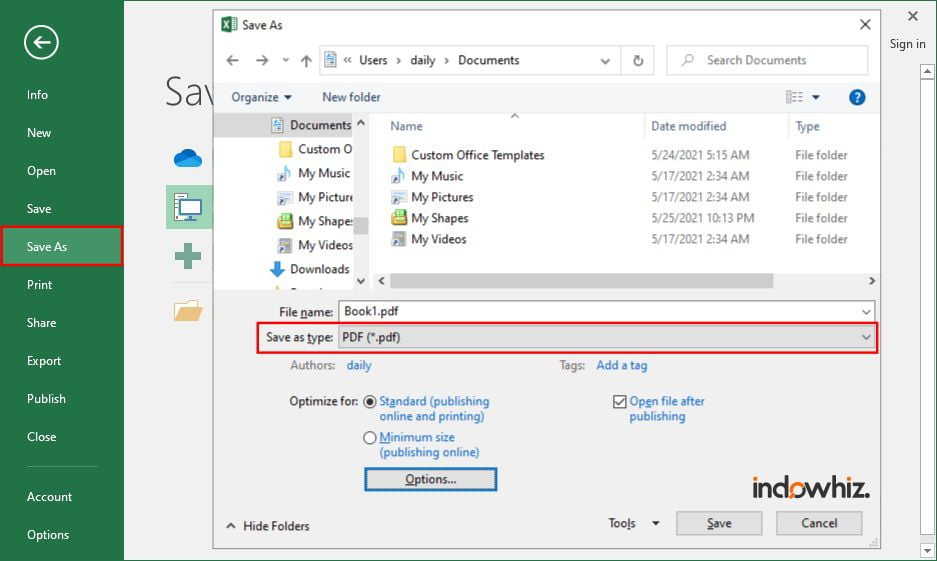
3.2. Export as EMF using Microsoft PowerPoint
While you can easily export the chart as PDF, you can also use Microsoft PowerPoint to create an EMF (Enhanced Windows Metafile) file from it.
Basically, you only need to do as in section 2.2 above. However, in this case, you need to select the EMF format in the 6th step.
References
- [1]Microsoft, “Excel help & learning,” Microsoft Office Support. https://support.microsoft.com/en-us/excel (accessed Jul. 24, 2021).
- [2]Microsoft, “Save a chart as a picture,” Microsoft Office Support. https://support.microsoft.com/en-us/office/save-a-chart-as-a-picture-254bbf9a-1ce1-459f-914a-4902e8ca9217 (accessed Jul. 24, 2021).



